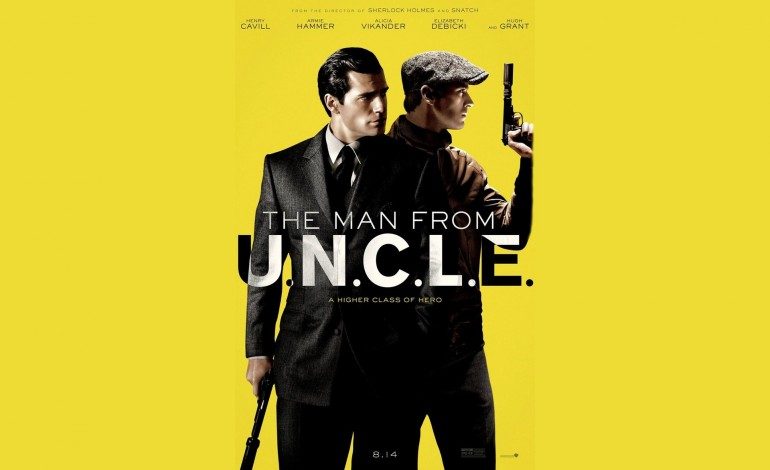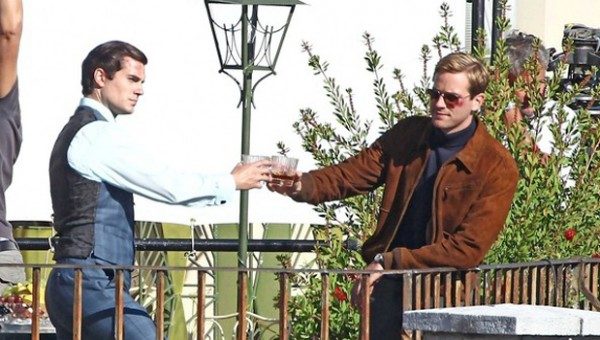

Guy Ritchie’s The Man From U.N.C.L.E. is the latest attempt to re-purpose an old, practically forgotten TV show into a big screen adventure for modern audiences. The classic Cold War-era series (which ran from 1964 to 1968) was about an American and Russian secret agent working together to stop global threats. Ritchie wisely keeps this movie adaptation remained firmly planted in its generational roots, which ends up being its greatest strength and the best reason to see it.
Set at the height of the Cold War, The Man from U.N.C.L.E. stars Henry Cavill as Napoleon Solo, a swindler-turned-CIA-agent who must team up with KGB agent Illya Kuryakin (Armie Hammer) and East German mechanic Gaby Teller (Alicia Vikander). Their mission: to stop the extraordinarily wealthy Victoria Vinciguerra (Elizabeth Debecki) from executing a potentially world-destroying plot involving easily-manufactured nuclear weapons. If this sounds like a plot taken from any of a thousand 1960s TV shows or movies – from Get Smart to Mission: Impossible to The Avengers (the Emma Peel/John Steed one)– it’s because it probably is. And the movie is all the better for it. The Man from U.N.C.L.E. is a 1960’s throwback in the best possible way.
Despite his proclivity towards excess, Ritchie manages to reel in some of his worst tendencies. While all of his films give the sense that he’s trying too hard to be cool, this is the one that comes across as the most effortless. Perhaps it’s because of its psychedelic 1960’s setting which is inherently cool, unlike say Victorian-era England. Ritchie (and the rest of the behind the scenes crew) have a seemingly palpable appreciation for this era. Their adaptation of this period/genre eschews an Austin Powers-esque irony in favor of respective recreation, from the clothing to the extravagant jewelry. Even his action sequences are rather relaxed – a major relief from the overlong, explosion-fueled mayhem of modern blockbusters.
Unfortunately, some of Ritchie’s other habits still shine through. He still has a penchant for set pieces that toe the line between moving the plot along and padding – fun sequences that enable the characters to get from Point A to Point B that nevertheless feel unnecessary. In most of Ritchie’s earlier movies (e.g. Snatch and Lock, Stock and Two Smoking Barrels), these moments never seemed out of place because the films were essentially over-the-top ensemble pieces, and of all the Tarantino-“tribute” artists of the late 1990s/early 2000s, he populated his films with the most colorful characters of the lot. Audiences cared less about how each piece contributed to the story and more about seeing actors like Brad Pitt and Jason Statham owning the screen. Ritchie’s Hollywood films (this one, as well as his two Sherlock Holmes films) still have these moments but the secondary characters lack the over-the-top qualities that make them truly memorable.
Yet to give credit where credit is due, the sojourns in The Man from U.N.C.L.E. are never particularly bothersome because the entire cast is uniformly quite good. Current Superman Henry Cavill shows a likeability missing from his portrayal of the Man of Steel as he mixes a cocky charm with a polite playfulness. (Not to mention his strange but strangely amusing “All American” voice with the enunciation that’s reminiscent of Phil Hartman). Armie Hammer, the Batman who never was, also has fun as a slightly dim-witted Russian superman (no pun intended). Notably, he actually works well in a partner role when not contending with an actor who is annoyingly – embarrassingly so – compelled to steal the spotlight in the most dreadful manner possible. Ex Machina‘s Alicia Vikander is similarly treated as virtually an equal to her two male leads and has a rougher edge that makes her something more than an “U.N.C.L.E. Girl.” Finally, The Great Gatsby scene stealer Elizabeth Debicki properly chews the scenery as an old-school villain who uses her sex appeal as much as her wits. Most crucially, they all have a fine chemistry playing against and off with one another.
Yet probably the biggest compliment I can pay to The Man From U.N.C.L.E. is that it’s a genuinely successful attempt to re-create a Connery-era James Bond movie. The simple, easy-to-follow plot, the toned down action, the megalomaniac villain, the easy-going witticisms/wry humor and the basic look of the film all do a fantastic job harkening back to this earlier time. A period when spy-action films could be pleasantly goofy without being stupid and these films were not compelled to be so relentlessly broody that they’re virtually joyless … not that that’s always a bad thing.
Verdict: 3 out of 5
The Man from U.N.C.L.E. is a good movie – good cast, good chemistry, good style, good action – but it’s just good. While it’s unfair to criticize a movie for not being exceptional, it also doesn’t rise to the level of “must see,” especially when contending with fellow spy film (and dominant brand) Mission: Impossible – Rogue Nation. That being said, The Man from U.N.C.L.E. definitely has a lot of potential as a super-stylish, Mission: Impossible-lite type franchise featuring fun, stand-alone adventures with a cast that’s fun to watch. While it probably won’t be box office gold, hopefully, it will find enough of a life on cable to warrant a sequel.



